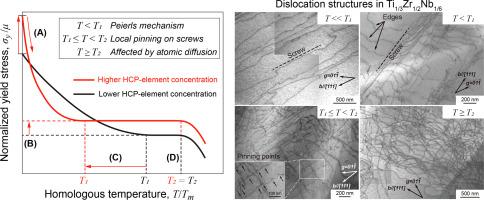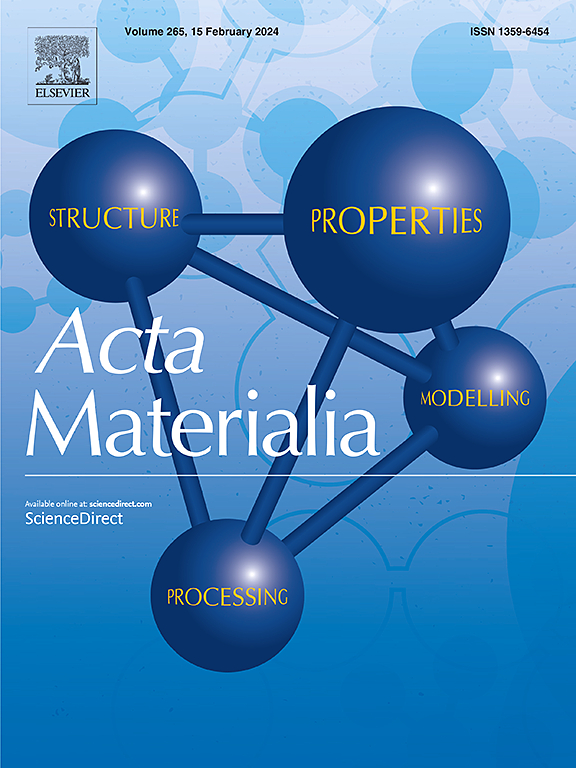HCP元素Ti和Zr对BCC组织Ti-Zr- nb中熵合金塑性变形行为的影响
IF 9.3
1区 材料科学
Q1 MATERIALS SCIENCE, MULTIDISCIPLINARY
引用次数: 0
摘要
本文研究了体心立方(BCC)结构的Ti-Zr- nb中熵合金(MEAs)在50 ~ 1173 K的压缩温度下的变形行为,并讨论了用均方原子位移(MSAD)量化的晶格畸变程度。所研究的所有Ti-Zr-Nb MEAs的屈服应力的温度依赖性与传统BCC金属和合金的屈服应力基本相同,在低温(T<T1)时快速下降,在中温(T1≤T<T2)时呈平稳期,在高温(T≥T2)时再次快速下降。变形机制由低温(T<T1)下的Peierls机制转变为高原温度(T1≤T<T2)下组成元素的非随机分布所产生的溶质团块在超高速下局部钉住螺位错的非热过程,钉住点之间的螺位错弓形结构证明了这一点。随着hcp元素浓度的增加,晶格畸变程度(MSAD)增加,对位错运动的抵抗能力增强,从而提高了0 K时的热应力和非热应力(即高原应力)。晶格畸变的增加也导致屈服应力在低温(T<T1)下的温度依赖性更大,从而导致高原的起始温度(T1)更低。本文章由计算机程序翻译,如有差异,请以英文原文为准。

Effects of HCP elements Ti and Zr on the plastic deformation behavior of Ti-Zr-Nb medium-entropy alloys with the BCC structure
The deformation behavior of Ti-Zr-Nb medium-entropy alloys (MEAs) with the body-centered cubic (BCC) structure has been investigated as a function of the HCP (hexagonal close-packed)-element (Ti and Zr) concentration in compression at temperatures between 50 and 1173 K and is discussed in terms of the extent of lattice distortion quantified as mean-square atomic displacement (MSAD). The temperature dependence of yield stress observed for all the Ti-Zr-Nb MEAs investigated is essentially the same as that observed for conventional BCC metals and alloys, featuring a rapid decrease at low temperatures (T < T1), a plateau at intermediate temperatures (T1 ≤ T < T2) and a rapid decrease again at higher temperatures (T ≥ T2). The deformation mechanism is converted from the Peierls mechanism at low temperatures (T < T1) to an athermal process involving local pinning of screw dislocations at superjogs presumably by solute cluster arising from non-random distributions of the constituent elements at plateau temperatures (T1 ≤ T < T2), as evidenced by the arc-shaped configurations of screw dislocations bowing-out between pinning points. The extent of lattice distortion (MSAD) increases with higher HCP-element concentration and enhances the resistance to dislocation motion, thereby raising both the thermal stress at 0 K and the athermal stress (i.e., the plateau stress). The increased lattice distortion also leads to the steeper temperature dependence of yield stress at low temperatures (T < T1) resulting in the lower onset temperature (T1) for the plateau.
求助全文
通过发布文献求助,成功后即可免费获取论文全文。
去求助
来源期刊

Acta Materialia
工程技术-材料科学:综合
CiteScore
16.10
自引率
8.50%
发文量
801
审稿时长
53 days
期刊介绍:
Acta Materialia serves as a platform for publishing full-length, original papers and commissioned overviews that contribute to a profound understanding of the correlation between the processing, structure, and properties of inorganic materials. The journal seeks papers with high impact potential or those that significantly propel the field forward. The scope includes the atomic and molecular arrangements, chemical and electronic structures, and microstructure of materials, focusing on their mechanical or functional behavior across all length scales, including nanostructures.
 求助内容:
求助内容: 应助结果提醒方式:
应助结果提醒方式:


